Learning Objects (LOs) are materials designed to be self-contained digital instructional units that can be combined to create a variety of learning experiences (ASTD & Smartforce 2002; Cramer 2007; McGreal 2004). Because LOs are organized and tagged with metadata, they can be retrieved by multiple users, such as learners or instructors, allowing LOs to be reused for different purposes (Recker, Walker & Wiley 2000; Learning Technology Standards Committee 2005). Learners might access an LO outside of the classroom environment in order to learn or practice a very specific area of study. Instructors might use an LO to introduce a new topic or follow-up a classroom activity. LOs may be confused with other internet-based learning activities and teaching tools such as WebQuests; however, the following elements characterize LOs and differentiate them from other computer-assisted learning activities. LOs are:
- digital,
- small
- self-contained,
- combinable with other chunks,
- reusable and adaptable, and
- organized with metadata.
Small in size, LOs are intended to help learners understand a narrow topic, a fractionated part of a process or a specific technique rather than a whole class, a unit or a course (Cramer 2007). Completing an LO can take as little time as one minute and should not take longer than 20 minutes.
As small, self-contained learning units, LOs consist of the four components below:
- an objective that describes the planned learning outcome on completion of an LO (Figure 1),
- a brief explanation of the target topic or skill (Figure 2),
- an interactive learning activity that allows learners to interact with a computer-based activity or real-life example in a multimedia format (Figure 3), and
- an assessment that gives instant feedback to learners’ work (Figure 4).
Figure 1. Passive Voice Learning Object. This figure shows the objective and metadata included in an LO.
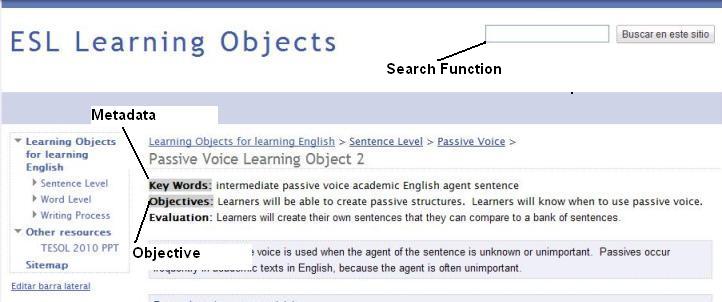
Figure 2. Passive Voice Learning Object Part II. This figure shows the explanation given in an LO.
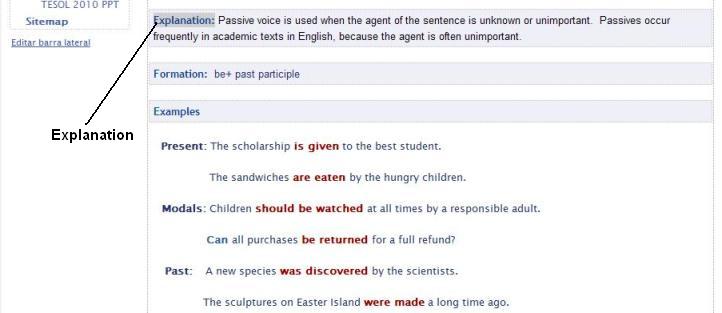
Figure 3. Passive Voice Learning Object Part III. This figure shows an interactive activity learners would complete. Note the link to instant feedback.
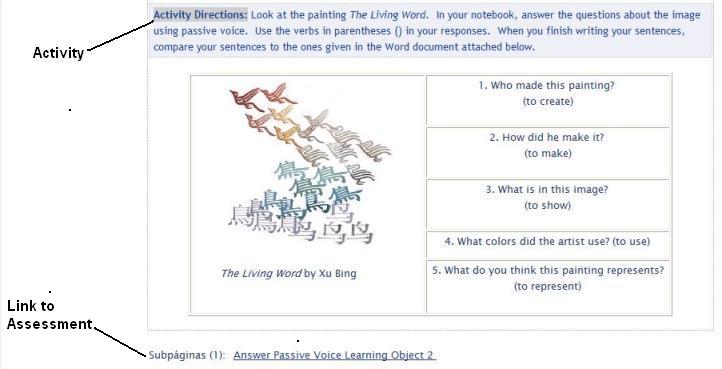
Figure 4. Passive Voice Learning Object Part IV. Students can compare their answers to the ones provided in the “Suggested Answers”.
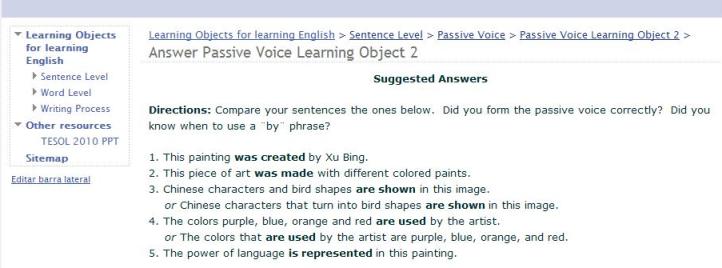
Another feature of LOs is combinability. Often compared to building blocks, which can create an infinite number of larger structures, LOs can be combined to create larger learning activities. Depending on their needs, teachers can use an LO individually or they can combine an LO with other LOs, projects or writing assignments. LOs are also reusable. Without adjustments or alteration, LOs should be usable by multiple teachers in different teaching contexts. Effective LOs are adaptable to various teaching and learning purposes.
Finally, LOs should contain descriptive information that allows teachers or students to easily locate them. This descriptive information is called metadata (see Figure 1). In the TESOL field, metadata can include information such as English levels, target grammar items, target skills, activity types and preconditions (Learning Technology Standards Committee 2002).
Advantages of LOs
Because LOs are a fairly new teaching technology, they have not been well-researched. Although there is a lack of data correlating the benefits of using LOs to facilitate language learning, one study indicated LOs positively affected learner outcomes. Students who utilized an LO repository as a part of three university-level French courses in Canada believed the LOs were useful for their language learning (Caws 2008). In these courses, students were given the freedom to access a bank of LOs to supplement their classroom studies. As long as the objectives of the LOs fitted the objectives of the course, the students reacted well to learning through LOs.
As suggested in Caws’ study, students who belong to Generation NEXT find computer-based learning opportunities appealing. They appreciate the accessibility of an LO bank, which can be used at any time as long as students have a computer with an internet connection. Ideally, students will use the LOs to answer questions they have about English as they arise, creating more autonomous learners. LOs create a rich learning environment where students can get the information they need right as they need it. Consider how reflexive it is for many people to look up an interesting topic or quickly check a fact on Wikipedia. Language learners could have that same kind of interaction with LOs.
Students are also attracted to the variety of activities LOs provide, which might meet the needs of their learning style better than a traditional textbook or classroom setting. LOs can be more easily and cheaply designed for visual and aural learners in particular. Banks of LOs can be housed for free on websites like GoogleSites and Weebly, or on Moodle, a learning management system. Although time-consuming to create, LOs are available to learners and instructors indefinitely once they are published on-line.
Offsetting the initial time investment is the potential for collaboration between teachers, departments, and school systems. (Torres, Marriot & Ramos 2009; Wiley, 2000) Collaborating to create LOs is especially advantageous for private school systems or public school districts that have multiple campuses and similar learning outcome goals. Even educators who work in different countries will find collaborating to build an LO database efficient and useful.
Whether teachers participate in creating LOs or not, they still gain greater flexibility in their method of delivering instruction if they use LOs. (de Salas & Ellis 2006) As we will demonstrate, teachers can use LOs to fulfill a variety of learning needs, such as homework, remediation activities, or as a part of a sequence for a longer project. Teachers can also design activities incorporating the LOs for multiple levels of learners, making them very efficient teaching tools.
Using LOs to teach English as a foreign language in Latin America has several distinct advantages. As computer technology and the internet play an increasingly important role in educational institutions in this region, more and more teachers are exploring ways to utilize these technologies in their instruction. However, buying computer-assisted learning software can be costly and is not affordable for all the institutions and students. For teachers who are not familiar with many computer programs, incorporating them into class is not an easy task. For such teachers and schools, LOs are an easier and cheaper option. LOs can be created by using free online materials, and teachers do not have to be computer experts to design LOs or access their databases.
Additionally, LOs can fill a gap in available resources teachers in Latin American may find. Schools often struggle to meet the costs of replacing lost or stolen teaching tools, nor may they be able to afford to order resources, such as magazines or books, from abroad. Unlike ESL settings, teachers know their students have very limited access to real-life English outside of the classroom. LOs can be a reasonable way to tackle that challenge because the Internet provides faster, inexpensive access to authentic English and LOs can be stored online safely.
Project Description and Rational
We started our LO project while we were working at a private university near Mexico City. Because of a strict graduation requirement which obligated students to achieve a minimum score of 520 on the Institutional TOEFL (Test of English as a Foreign Language) test, the English courses were heavily focused on discrete grammar skills and drill-based written exercises. In the rigid, grammar-based curriculum, we found it very difficult to motivate students. We also felt that grammar should be taught in a more integrated and interactive way through various types of activities to benefit students with different learning styles. As a way of addressing these issues, we decided to develop a collection of LOs. In order to meet the institution’s goals, the LOs were designed to support grammar and writing instruction.
Our LO bank currently contains forty LOs under three main categories: Sentence Level, Word Level and Writing Process with sub-categories under each main category (see Figure 5). We have developed and implemented the LO database into our classes over the past year and a half, and the LOs have been used by university students, professors and administrative personnel in Mexico, and by ESL students in an intensive English program in the U.S.A. The students’ English proficiency level ranges from beginners to high-intermediates. The instructors made individual choices about when to present a particular LO and how to apply it in class.
Figure 5. LO Bank Sitemap. This figure shows the organization of the LO database.
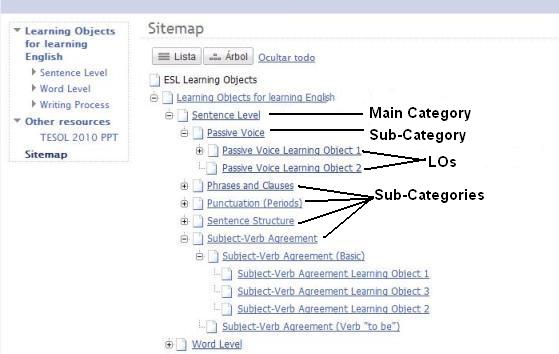
Our LO Database
We used GoogleSites, which is a free webpage builder, to create the LO bank. GoogleSites worked perfectly for us because it is free, requires little work to maintain and is easily accessible for both teachers and students. It also offers a search function, which allows users to search for LOs by inserting keywords, and offers free gadgets such as a bilingual Spanish-English dictionary, a calculator and world time clocks and a calendar, which were useful when we created our LOs from scratch. In addition, Google and YouTube video clips can easily be inserted. We found it relatively easy to design and maintain our LOs and webpage.
We decided to invest time in designing our own LOs because there is a limited number of LOs available that are specifically designed for EFL students or that could be adapted to EFL instruction. In situations where existing online materials partially met the needs of our students, we incorporated them into LOs.
Using existing online materials
We used existing online materials and turned them into LOs by adding an objective, explanation and/or evaluation. When we designed an LO to teach the vocabulary of the months of the year, for instance, we incorporated an existing video clip which illustrates and pronounces the target vocabulary while showing corresponding images. We used an online-spelling game for the interactive learning activity. Not only did we use ESL learning activities and exercises, but also cartoon strips, an online newspaper, children’s stories, YouTube video clips, music files, advertisements and educational websites such as Time for Kids, National Geographic Kids and UPFRONT.
Creating LOs from scratch
We created interactive activities using the free software Hot Potatoes. This software enables educators to design web-based crossword, gap-fill and multiple choice exercises. We also used voice recorded materials and included them as WAV files. To design explanations, we used original charts, graphs and PowerPoint presentations.
Dealing with reusability
As we mentioned in the introduction, reusability is an important function of LOs. To make our LOs adaptable through multiple levels of English courses, we tried to control vocabulary by using non-verbal input such as pictures, video and music. We also provided links to free online dictionaries such as The Newbury House Dictionary of American English and Macmillan Dictionary, or we simply inserted the online dictionary GoogleSites provides. We made sure to break topics down into the smallest chunks possible so that LOs would be flexible enough to be used flexibly for different teaching purposes.
Application of LOs in our classes
Individual LOs
Homework
LOs can easily be used as homework to lead up to an in-class activity. For example, in the high-intermediate group, students completed the LOs on passive voice. They read about the construction and the use of passive voice, completing an activity about passive voice form and another activity in which they had to write individual sentences about visual art. The next day in class we checked the homework as a group. Then the students completed a scavenger hunt to find sculptures displayed on campus. Afterward, they created short paragraphs, using sentences with passive voice, to describe the sculptures they found.
LOs may also be used as homework to reinforce concepts introduced in class. For example, after beginning level students learned the difference between a common and proper noun, they completed the LOs covering those topics. The instructor collected print-outs of the LOs and graded them as homework.
Remediation
When instructors notice that students are struggling with a particular topic that they should already know, they can assign LOs on that topic for students to complete. Since the LOs provide feedback to the learners, teachers do not have a lot of extra grading to do but can simply check that students completed the assigned activities. Assigning LOs can be especially useful in a multi-level class where lower level students are struggling, but teachers do not want to bore more advanced students with whole group remedial activities.
Extra practice
Students may decide that they would like additional practice with a particular topic. When they ask the instructor for help, he or she can assign relevant LOs for students to complete. As with remediation activities, LOs do not require a lot of extra work for the teacher. Should any problems arise for the students during the course of completing the LOs, students can discuss those issues with the instructor during a tutoring session.
Classroom activity
LOs can also be a part of a well-planned classroom activity. The university where we taught provides a computer lab solely for the use of language learners. We were able to use this lab in the high-intermediate courses to complete an activity focused on working with compound sentences. Students completed the LOs that introduced compound sentences and compound coordinators. This LO required students to listen to different musicians and make comparisons between their music. Students then interviewed each other about their musical preferences and what they liked or did not like in the music they heard through the LO. As homework, students wrote a paragraph comparing the preferences of their interview subjects. They used compound sentences in their paragraph.
Multiple LOs combined with larger assignments
With a writing assignment
As Figure 6 indicates, multiple LOs were used between the first draft and the final draft of a writing assignment. The whole process took about a week. The objectives for the assignment included introducing the concept of proof-reading and developing the students’ awareness of monitoring and correcting their own mistakes in writing. Reinforcing students’ understanding of subject-verb agreement, which is a frequently occurring TOEFL grammar question, was also an important goal. Five LOs from the bank were used to address these issues.
First, high-beginning EFL students were asked to write a paragraph of twelve sentences discussing their eating habits and food preferences. Then students were required to proof-read their first drafts by using one of the proof-reading techniques that they practiced through the LOs. The items from the Subject-Verb LO were included in the evaluation rubric and checked for accuracy.
Figure 6. A Writing Assignment with Multiple LOs. This figure shows the sequence of using LOs as a secondary step of a larger writing assignment.

With a term project
LOs were used as a vocabulary-expansion activity for a term project (Figure 7). After completing the assigned LOs, beginning EFL students wrote a paragraph of 8-12 sentences describing their daily routines and gave a brief oral presentation. The LOs were created and used as supplementary exercises to review the previously taught vocabulary and to expand their vocabulary on the target topic. They were required to use the words and expressions both from the textbook and the LOs. Completion of the LOs and use of a wide range of vocabulary were included in the evaluation rubric.
Figure 7. A Term Project with Multiple LOs. This figure shows the sequence of LOs and point distribution of a beginning-level term project.

Designing a whole class using multiple LOs
Another way to approach the use of multiple LOs is to combine them to create an entire in-class lesson sequence. This idea can be especially useful when a teacher cannot find a substitute teacher for her/his absence but does not want the students to get behind with the material. See Appendix 1 for an example of a whole-class lesson using LOs. The lesson was planned for adult learners at the beginning level.
Analysis of student responses
Students who used the LOs had an overwhelmingly positive response to them. After the first semester that we used LOs in our classes, we gave the students a questionnaire that asked them whether or not they liked the LOs. The students were also asked the reasons why they did or did not like the LOs (Table 1). Students could select multiple reasons for liking or disliking the LOs, and they were encouraged to write comments to support their responses. Sixty-three high-intermediate, 20 high-beginning, and six beginning level students responded. All were between the ages of 17 and 23, and most were within their first two semesters at a private university in Mexico.
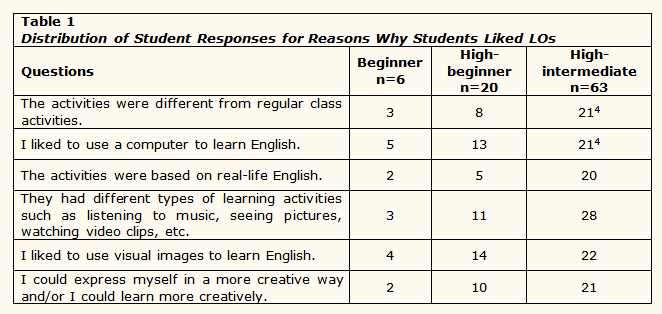
We found that the majority of the students liked the LOs. All 26 students at the beginning and high-beginning levels said they liked the LOs, and only 5 students in the high-intermediate level said they disliked them. Those students said they did not enjoy using a computer to learn English and found the activities confusing. One beginner and high-beginner were also confused by the LOs.
As indicated in the table, students seemed to enjoy using a computer to learn English, which is in agreement with Caws’ (2008) findings. Many students also selected option 4, which indicates they appreciate the variety of tasks offered in LOs and, quite possibly, a break from class routine. Students might also have selected this option because the variety of media and exercises offered in LOs inherently appeals to different learning styles. Interestingly, a large majority of beginners and advanced beginners said they liked using visuals to learn English, while a much smaller percentage of high-intermediates made this choice on their questionnaires. One reason the visuals in LOs may be so attractive to lower-level English learners is because they rely more heavily on visual cues to help them comprehend and produce the language.
In addition to the students’ responses on the questionnaire, we noticed that students appeared engaged with the material when they worked on it in the computer lab. We saw heightened levels of interest with class activities that built off of LOs, and we felt it added a fun layer of variety to short classes that could easily become monotonous. Based on their increased motivation to complete those activities, we also believe that students could be encouraged toward more autonomous learning behaviors. They could become interested enough to complete some of the LOs on their own.
Reflection
Although the database of LOs was time-consuming to create, we feel the project was a success. Students enjoyed practicing English grammar and writing with the LOs, and other teachers have expressed interest in using the online materials. Having created the bank of LOs, we have been able to use them with multiple classes, which has helped us make up the time we invested in the project. We also see enormous potential for other teachers to get involved to create a large, free network of English language activities that students could access at any time and teachers could use free of charge in their classes. The more people that are involved with such a project, the less time individual participants would have to spend on it. In addition, time could be saved by creating connections to existing LO sites. While few in number, some institutions have created useful LOs that would appeal to adult learners, especially to introduce writing and grammar topics.
Regarding our own project, we realize that we did not create LOs with young learners in mind since we were only working with university students. We do believe, however, that creating LOs for primary and secondary school learners would be beneficial. With a wealth of English language educational games available on-line as well as vibrant images and interesting sound bytes, educators should be able to create engaging LOs for this age group. The internet has made it increasingly easy for educators to collaborate, and we see the potential for successful collaborations not only within departments but internationally. Teachers of young learners all over the world might be able to come together to create a great resource for their classrooms.
Even as we move on to different instructional settings, we plan on continuing to develop our bank of LOs, and we have a few ideas in mind for its improvement. First, we would like to develop LOs that address spoken English. We are hopeful that we can find software that would permit students to record and listen to their own voices. We may be able to make use of programs like Skype that will allow students to talk to each other or to native English speakers. Second, we are committed to improving our use of authentic English texts, even with its inherent vocabulary challenges. Providing students with greater access to real-life uses of English is one of the greatest difficulties for EFL instructors, but we think that students who are exposed to it better understand their own needs as learners. We also believe that those texts are more interesting and motivating to students. In future classes, we would like to test this by creating learner portfolios as they complete LOs. As students choose the LOs they feel best meet their needs as learners, they would provide regular, written responses to what they are learning through the process. Not only do we believe that will help students to become better at identifying and fulfilling their own learning needs, but also we think it will help educators to get a deeper understanding of how language learners make use of open access to a wide network of learning activities.
Language instructors who want to try using LOs in their own courses may find ways to make LOs fit a socio-constructivist approach to language learning in an extension of the previously described journal activity. By encouraging students to create online journals where they share what they are learning and the LOs they have used with other learners, students could create a network of learning support that bypasses the instructor. Another idea one of the authors is currently experimenting with is learner-designed LO activities created for other language learners. The underlying assumption for this activity is that learners who must teach a target structure learn the structure better themselves. Additionally, it provides learners with the opportunity to reflect on what kinds of activities they found most useful in learning that structure and whether those activities would be helpful for other language learners. Other instructors might find this a helpful model for generating more learner-centered approaches to LO creation and use.
To conclude, we do not believe that computer-based approaches are necessarily the best way to learn English, but we have found that LOs can be an effective tool in increasing student motivation to complete class work and homework. Furthermore, we believe LOs can be used in a way that promotes student-centered learning using a socio-constructivist approach. We look forward to seeing new, creative applications of LOs in the language classroom.
References
ASTD and Smartforce. (2002). A field guide to learning objects. Retrieved May 12, 2009, from http://db.formez.it/fontinor.nsf/c658e3224c300556c1256ae90036d38e/30AE7A876BD011A7C1256E59003A4943/$file/smartforce.pdf
Caws, C. (2008). Development and implementation of a learning object repository for French teaching and learning: Issues and promises. CALICO Journal. 26(1), 123-141.
Cramer, S.R. (2007). Update your classroom with learning objects and twenty-first century skills. The Clearing House, 80(3), 126-132.
de Salas, K. & Ellis, L. (2006). The development and implementation of learning objects in a higher education setting [Electronic version]. Interdisciplinary Journal of Knowledge and Learning Objects, 2, 1-22.
IEEE Learning Technology Standards Committee. (2005). MG12: Learning Object Metadata. Retrieved May 11, 2010, from http://ltsc.ieee.org/wg12
McGreal, R. (2004). Learning objects: A practical definition. International Journal of Instructional Technology and Distance Learning, 1(9). Retrieved May 15, 2010, from http://itdl.org/Journal/Sep_04/index.htm
Recker, M. M., Walker, A., & Wiley, D. A. (2000). Collaboratively filtering learning objects. In D. A. Wiley (Ed.) The Instructional Use of Learning Objects [Electronic version]. Retrieved May 11, 2010, from http://reusability.org/read/chapters/recker.doc
Sakurai, Y. & Donelson, R. (2008). ESL learning objects. Retrieved from http://sites.Google.com/site/esllearningobjects/home
Torres, P., Marriot, R. & Ramos, A. (2009). English-language teaching with learning objects at PUCPR. In R. Marriot & P. Torres (Eds.) Handbook of Research on E-learning Methodologies for Language Acquisition (pp.120-131). Hershey, PA: Information Science Reference.
Wiley, D. (2000). Connecting learning objects to instructional design theory: A definition, a metaphor, and a taxonomy. In D. Wiley (Ed.) The Instructional Use of Online Learning Objects [Electronic version]. Retrieved May 27, 2009, from www.reusability.org="">http://www.reusability.org/read

